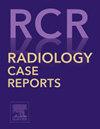当救生措施导致创伤时:心肺复苏后的肝囊下血肿
Q4 Medicine
引用次数: 0
摘要
心肺复苏术(CPR)是治疗心脏骤停的重要干预措施,但由于胸外按压的力量过大,可能导致严重的内伤。其中,肝囊下血肿是一种罕见的严重并发症。我们在此介绍一名 55 岁的男性患者,他有酗酒史,因严重缺血性中风而需要进行心肺复苏,随后出现无脉性室性心动过速。复苏后,患者出现肝囊下血肿,可能是胸外按压造成的创伤。患者的临床病程也很复杂,包括中风的出血性转化和双侧肺栓塞导致的抗凝治疗,这使得肝血肿的处理更加复杂。在患者出现腹部不适加重和内出血迹象后,通过对比增强 CT 成像确定了血肿。处理的重点是平衡抗凝治疗的需要和血肿进一步出血的风险。必须采取多学科方法,包括密切监测、潜在的手术干预和仔细调整抗凝疗法。该病例强调了认识到心肺复苏术后可能出现内伤的重要性,尤其是需要抗凝治疗的患者。通过成像及多学科协调方法及早发现此类并发症并改善患者预后至关重要。本文章由计算机程序翻译,如有差异,请以英文原文为准。
When life-saving measures lead to trauma: Subcapsular hepatic hematoma after CPR
Cardiopulmonary resuscitation (CPR) is a critical intervention for cardiac arrest but can result in significant internal injuries due to the force of chest compressions. Among these, subcapsular hepatic hematoma is a rare and serious complication. Here we present a 55-year-old male with a history of alcohol abuse presented with a severe ischemic stroke and subsequently required CPR due to pulseless ventricular tachycardia. Following resuscitation, the patient developed a subcapsular hepatic hematoma, likely caused by the trauma of chest compressions. The patient also had a complex clinical course involving hemorrhagic conversion of the stroke and the need for anticoagulation due to bilateral pulmonary emboli, which further complicated the management of the hepatic hematoma. The identification of the hematoma was achieved through contrast-enhanced CT imaging after the patient exhibited worsening abdominal discomfort and signs of internal bleeding. The management focused on balancing the need for anticoagulation with the risks of further bleeding from the hematoma. A multidisciplinary approach was essential, involving close monitoring, potential surgical intervention, and careful adjustment of anticoagulant therapy. This case emphasizes the importance of recognizing the potential for internal injuries following CPR, especially in patients requiring anticoagulation. Early detection through imaging and a coordinated, multidisciplinary approach are crucial in managing such complications and improving patient outcomes.
求助全文
通过发布文献求助,成功后即可免费获取论文全文。
去求助
来源期刊

Radiology Case Reports
Medicine-Radiology, Nuclear Medicine and Imaging
CiteScore
1.10
自引率
0.00%
发文量
1074
审稿时长
30 days
期刊介绍:
The content of this journal is exclusively case reports that feature diagnostic imaging. Categories in which case reports can be placed include the musculoskeletal system, spine, central nervous system, head and neck, cardiovascular, chest, gastrointestinal, genitourinary, multisystem, pediatric, emergency, women''s imaging, oncologic, normal variants, medical devices, foreign bodies, interventional radiology, nuclear medicine, molecular imaging, ultrasonography, imaging artifacts, forensic, anthropological, and medical-legal. Articles must be well-documented and include a review of the appropriate literature.
 求助内容:
求助内容: 应助结果提醒方式:
应助结果提醒方式:


